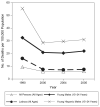Health disparities in the Latino population
- PMID: 19713270
- PMCID: PMC5044865
- DOI: 10.1093/epirev/mxp008
Health disparities in the Latino population
Abstract
In this review, the authors provide an approach to the study of health disparities in the US Latino population and evaluate the evidence, using mortality rates for discrete medical conditions and the total US population as a standard for comparison. They examine the demographic structure of the Latino population and how nativity, age, income, and education are related to observed patterns of health and mortality. A key issue discussed is how to interpret the superior mortality indices of Latino immigrants and the subsequent declining health status of later generations. Explanations for differences in mortality include selection, reverse selection, death record inconsistencies, inequalities in health status, transnational migration, social marginality, and adaptation to environmental conditions in the United States. The utility of the public health social inequality framework and the status syndrome for explaining Latino disparities is discussed. The authors examine excess mortality from 8 causes: diabetes, stomach cancer, liver cancer, cervical cancer, human immunodeficiency virus/acquired immunodeficiency syndrome, liver disease, homicide, and work-related injuries. The impact of intergenerational changes in health behavior within the Latino population and the contributory role of suboptimal health care are interpreted in the context of implications for future research, public health programs, and policies.
Figures







References
-
- Whitehead M. The concepts and principles of equity and health. Int J Health Serv. 1992;22(3):429–445. - PubMed
-
- Argeseanu Cunningham S, Ruben JD, Narayan KM. Health of foreign-born people in the United States: a review. Health Place. 2008;14(4):623–635. - PubMed
-
- Palloni A, Ewbank DC. Selection processes in the study of racial and ethnic differentials in adult health and mortality. In: Anderson NB, Bulatao RA, Cohen B, editors. Critical Perspectives on Racial Differences in Health in Later Life. National Research Council; Washington, DC: 2004. pp. 171–226.
-
- Stephen EH, Foote K, Hendershot GE, et al. Health of the foreign-born population: United States, 1989–90. Adv Data. 1994;(241):1–12. - PubMed

